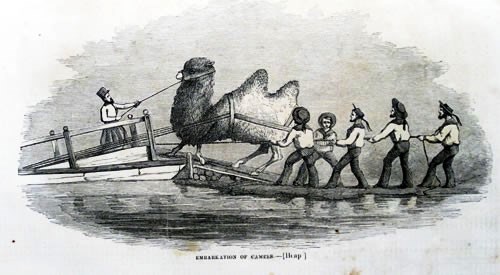Congress, Camels, and California
Camel at Drum Barracks, San Pedro, California, during the Civil War, c. 1863
Attributed to Rudolph D’Heureuse; courtesy of the Drum Barracks Garrison & Society
As a mode of transportation, few would guess that camels in California would qualify. Yet, on this day in 1855, the U.S. Congress approved $30,000 for an experiment using camels as pack animals to cross the desert to California for military purposes.
By 1857, due largely to the efforts of Secretary of War Jefferson Davis, the experiment had met with some success. In that year 75 camels were imported from Egypt by ship to serve the U.S. Army in the Southwest. One group of camels was selected to pack supplies from Los Angeles to Fort Tejon in California; others to transport military supplies to forts in Utah, Arizona, Texas, and New Mexico.
Gwynn H. Heap (illustrator), Loading the Camels for Transport to America, 1857
Published in Report of the Secretary of War, Communicating, in Compliance with a Resolution of the Senate of February 2, 1857, Information Respecting the Purchase of Camels for the Purposes of Military Transportation (Washington: A. O. P. Nicholson, printer, 1857)
Courtesy National Archives
“Camels Secured for a Gale, page 180 of Report of the Secretary of War (1857),” 1930
Published in A. A. Gray, Francis P. Farquhar, and William S. Lewis, Camels in Western America
(San Francisco: California Historical Society, 1930)
In January 1858 the first train of pack camels had crossed the desert and arrived in Los Angeles. Their task was to carry supplies and provisions to Fort Tejon in the Tehachapi Mountains. As a 1902 historical record of Southern California noted, “For a year or more afterwards it was no uncommon sight to see a caravan of these hump-backed burden-bearers solemnly wending their way single file through the city.”
W. D. Smithers (cartographer), Map of the Overland Route of the Camels from Texas to California,
1857–1858, date unknown
1857–1858, date unknown
Courtesy https://texashistory.unt.edu/ark:/67531/metapth11952/
Encampment with the Camels on the Descent towards Carson Valley, c. 1860
Vischer’s Pictorial of California (View No. 47)
California Historical Society
“Camels arrived in California in 1858 at Drum barracks, Wilmington, Calif.,” detail,
California Centennial Transportation Plate, 1949
Private Collection of Phyllis Hansen
In California, camels were brought to the military reservation at Benicia, where they were lodged and later auctioned off. Today the Camel Barns at the Arsenal house the Benicia Historical Museum.
Camel Barn, Old Benicia Arsenal, 2014
Courtesy http://westerntrips.blogspot.com/2014_05_01_archive.html
Still other camels were turned loose, to roam at will over the region. As the writers of the 1939 WPA Guide to California: The Golden State observed:
Within recent years a camel frisked about the neighborhood of Banning, making such a nuisance of himself that he was hunted down by a posse and shot. This was undoubtedly an aged survivor of the government caravans that cross the desert prior to the Civil War. . . . Some wild camels were sighted on the desert as late as 1980, and even now newcomers [to Banning] are solemnly assured they can expect to run into them at any moment.Shelly Kale
Publications and Strategic Projects Manager
skale@calhist.org
Sources
- Charles C. Carroll, “The Government's Importation of Camels: A Historical Sketch,” Report of the Chief of the Bureau of Animal Industry, United States Department of Agriculture 20 (1903): 391–409
- Jefferson Davis, Reports upon the Purchase, Importation, and Use of Camels and Dromedaries to Be Employed for Military Purposes (Department of War, 1857)
- Francis P. Farquhar, “Camels in the Sketches of Edward Vischer,” California Historical Society Quarterly 9, no. 4 (Dec., 1930): 332–35
- Federal Writers’ Project, The WPA Guide to Los Angeles: The Golden State (San Antonio, TX: Trinity University Press, 2013)
- Walter L. Fleming, “Jefferson Davis’s Camel Experiment,” Popular Science Monthly, 174 (Feb. 1909): 141–52.
- A.A. Gray, “Camels in California,” Quarterly of the California Historical Society IX, no. 4 (December 1930): 229–317
- J. M. Guinn, “Camel Caravans of the American Deserts,” Publications of the Historical Society of Southern California and of the Pioneers of Los Angeles County, 5 (1900–1902): 146–51
- James Miller Guinn, Historical and Biographical Record of Southern California (Chicago; Chapman Publishing company, 1902)
- Michael K. Sorenson, “A Most Curious Corps,” Military Images Magazine (March/April 2006.








No comments:
Post a Comment